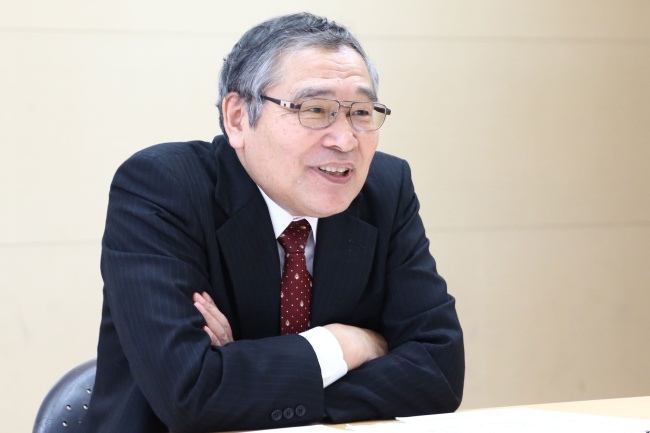- Home
- > Outreach
- > Publications
- > CONVERGENCE
- > INTERVIEW
 INTERVIEW
INTERVIEW
An Interview with Prof. Gunzi Saito WPI Program Officer

− First, what is your overall evaluation of the activities of MANA?
MANA’s activities are extremely outstanding. Looking at its work as a whole, it is perfectly fair to say this: MANA laid out “Three Grand Challenges” as targets, and it has made great progress toward achieving those goals.
− Among the centers in the WPI Program, MANA is the only one that is not affiliated with a university. Could you comment on the distinctive features of MANA because it is one of national laboratories?
The universities with WPI centers have faculties of around 4500 to 7500 people in the total university corporation. In contrast to this, the number of full-time researchers at NIMS, which is the host organization of MANA, is only around 400. The annual budget of NIMS is also about 1/ 5 to 1/ 9 that of the universities. For this reason, the annual WPI budget of somewhat over a billion yen was very important for NIMS, and the people at MANA had to take this very seriously.
In addition, at the universities, the host organization is too large, and the individual departments are too strong. In contrast, NIMS is small in scale, and it doesn’t take too long to convince people who may oppose some idea. The organization and operational capabilities of NIMS were strong. On the other hand, scientists at national laboratories excel in producing results that can be obtained quickly by following an outstanding path, but they aren’t accustomed to grappling boldly with “crazy” research. Thus, activating research based on truly innovative ideas was an issue.
− The Missions of the WPI Initiative are 1) Achieving the world’s highest level of research, 2) Creating interdisciplinary research domains, 3) Realizing a global research environment and 4) Reforming the research organization. How was MANA doing in realizing these Missions?
When MANA was selected, I told them that there were many excellent people, but please develop “supermen” who were even more exceptional. Initially, MANA responded by assembling a group of truly excellent researchers from other countries. This was followed by outstanding young researchers from overseas. The Japanese researchers see the work of those people and make their own best efforts. As a result, the Japanese researchers have grown to the point where they are also producing extremely good results. In this way, MANA has come to function as global hub of nanotechnology research.
MANA’s organization-building capabilities were also extremely good. In management and operation, MANA could cope with a variety of jobs thanks to the “troika system” of the Director-General, COO and Administrative Director. I think that this has worked effectively in achieving the goals of MANA, including the creation of a friendly research environment for non-Japanese researchers, and it has also made a substantial contribution to organizational reform in the host organization, NIMS.
It was good that MANA selected Nobel Laureate scientists to serve as Advisors. To compete with that, the level of the Evaluation Committee that evaluates MANA has also been raised, and MANA’s reputation has increased as a result of very vigorous discussions aimed at improving the research center.
Although there are various patterns for “Creating interdisciplinary research domains,” the concept of “nanoarchitectonics” advocated by Director-General Aono is basis for this at MANA, and interdisciplinary research has progressed in the new paradigms that were born from that concept. During FY 2016, MANA established the new field of Nano-Theory and added theorists to its organization. I hope that this will spur a further friendly rival, accompanied by keen disputes, between MANA’s experimental scientists and theoretical scientists.
− MANA has also put great ef fort into developing young human resources.
The quality of MANA’s human resources development is on the highest level, even among the WPI centers. Prof. Kishi, who was the President of NIMS when MANA was selected for the WPI Program, put considerable effor t into developing young international human resources even before MANA was launched. At MANA, Director-General Aono and COO Bando encouraged bottom-up type research projects, and not projects directed from above. The flexible thinking and way of responding of these top managers (Prof. Kishi and former President of NIMS Prof. Ushioda, and Dr. Aono and Dr. Bando of MANA) was also very fortunate. I am truly impressed by the large number of young researchers who have achieved astonishing growth.
− In April of 2017, Prof. Sasaki will succeed Prof. Aono as Director-General of MANA. What are your expectations for the new Director-General Sasaki?
The word “nanoarchitectonics” is really wonderful, but there are still many issues for deepening this concept from the viewpoint of materials science, for example, development of devices for manipulating atoms and molecules, pursuing original research in the life sciences field and so on. If new concepts are created, this should give birth to new fields, and the future should be very interesting. Therefore, I hope that the new Director-General Sasaki will actively pioneer new fields and encourage even greater development of “nanoarchitectonics.”
MANA’s activities are extremely outstanding. Looking at its work as a whole, it is perfectly fair to say this: MANA laid out “Three Grand Challenges” as targets, and it has made great progress toward achieving those goals.
− Among the centers in the WPI Program, MANA is the only one that is not affiliated with a university. Could you comment on the distinctive features of MANA because it is one of national laboratories?
The universities with WPI centers have faculties of around 4500 to 7500 people in the total university corporation. In contrast to this, the number of full-time researchers at NIMS, which is the host organization of MANA, is only around 400. The annual budget of NIMS is also about 1/ 5 to 1/ 9 that of the universities. For this reason, the annual WPI budget of somewhat over a billion yen was very important for NIMS, and the people at MANA had to take this very seriously.
In addition, at the universities, the host organization is too large, and the individual departments are too strong. In contrast, NIMS is small in scale, and it doesn’t take too long to convince people who may oppose some idea. The organization and operational capabilities of NIMS were strong. On the other hand, scientists at national laboratories excel in producing results that can be obtained quickly by following an outstanding path, but they aren’t accustomed to grappling boldly with “crazy” research. Thus, activating research based on truly innovative ideas was an issue.
− The Missions of the WPI Initiative are 1) Achieving the world’s highest level of research, 2) Creating interdisciplinary research domains, 3) Realizing a global research environment and 4) Reforming the research organization. How was MANA doing in realizing these Missions?
When MANA was selected, I told them that there were many excellent people, but please develop “supermen” who were even more exceptional. Initially, MANA responded by assembling a group of truly excellent researchers from other countries. This was followed by outstanding young researchers from overseas. The Japanese researchers see the work of those people and make their own best efforts. As a result, the Japanese researchers have grown to the point where they are also producing extremely good results. In this way, MANA has come to function as global hub of nanotechnology research.
MANA’s organization-building capabilities were also extremely good. In management and operation, MANA could cope with a variety of jobs thanks to the “troika system” of the Director-General, COO and Administrative Director. I think that this has worked effectively in achieving the goals of MANA, including the creation of a friendly research environment for non-Japanese researchers, and it has also made a substantial contribution to organizational reform in the host organization, NIMS.
It was good that MANA selected Nobel Laureate scientists to serve as Advisors. To compete with that, the level of the Evaluation Committee that evaluates MANA has also been raised, and MANA’s reputation has increased as a result of very vigorous discussions aimed at improving the research center.
Although there are various patterns for “Creating interdisciplinary research domains,” the concept of “nanoarchitectonics” advocated by Director-General Aono is basis for this at MANA, and interdisciplinary research has progressed in the new paradigms that were born from that concept. During FY 2016, MANA established the new field of Nano-Theory and added theorists to its organization. I hope that this will spur a further friendly rival, accompanied by keen disputes, between MANA’s experimental scientists and theoretical scientists.
− MANA has also put great ef fort into developing young human resources.
The quality of MANA’s human resources development is on the highest level, even among the WPI centers. Prof. Kishi, who was the President of NIMS when MANA was selected for the WPI Program, put considerable effor t into developing young international human resources even before MANA was launched. At MANA, Director-General Aono and COO Bando encouraged bottom-up type research projects, and not projects directed from above. The flexible thinking and way of responding of these top managers (Prof. Kishi and former President of NIMS Prof. Ushioda, and Dr. Aono and Dr. Bando of MANA) was also very fortunate. I am truly impressed by the large number of young researchers who have achieved astonishing growth.
− In April of 2017, Prof. Sasaki will succeed Prof. Aono as Director-General of MANA. What are your expectations for the new Director-General Sasaki?
The word “nanoarchitectonics” is really wonderful, but there are still many issues for deepening this concept from the viewpoint of materials science, for example, development of devices for manipulating atoms and molecules, pursuing original research in the life sciences field and so on. If new concepts are created, this should give birth to new fields, and the future should be very interesting. Therefore, I hope that the new Director-General Sasaki will actively pioneer new fields and encourage even greater development of “nanoarchitectonics.”
Gunzi Saito
Prof. Saito completed his degree in the Department of Chemistry, Graduate School of Science, Hokkaido University in 1972, and has been a Visiting Professor at the Okazaki National Research Institutes, University of Tokyo and University of Rennes 1 (France), as well as Director of the Research Center for Low Temperature and Materials Sciences, Kyoto University. Since 2012, he has been Professor of the Faculty of Agriculture, Meijo University. He has received many prestigious awards, including the Nishina Memorial Prize and the Shijuhosho Award (Medal of Honor with Purple Ribbon).
Prof. Saito completed his degree in the Department of Chemistry, Graduate School of Science, Hokkaido University in 1972, and has been a Visiting Professor at the Okazaki National Research Institutes, University of Tokyo and University of Rennes 1 (France), as well as Director of the Research Center for Low Temperature and Materials Sciences, Kyoto University. Since 2012, he has been Professor of the Faculty of Agriculture, Meijo University. He has received many prestigious awards, including the Nishina Memorial Prize and the Shijuhosho Award (Medal of Honor with Purple Ribbon).

